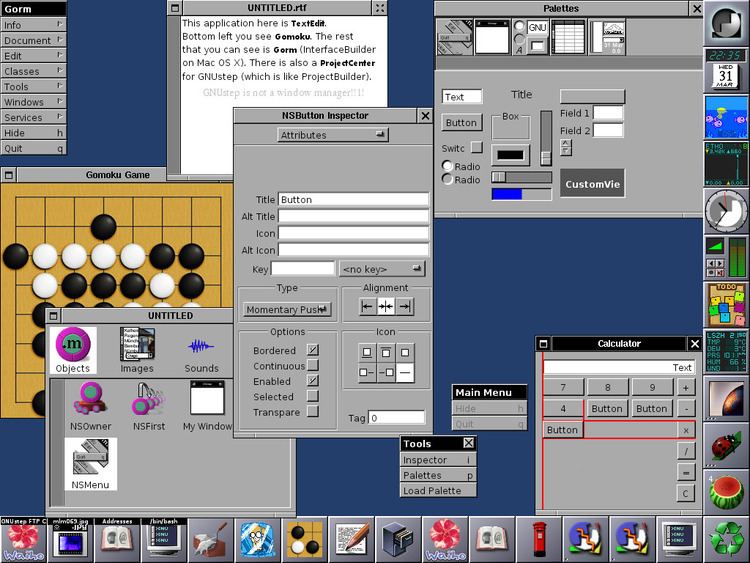Developer(s) GNUstep Developers Operating system | Type Widget toolkit | |
 | ||
Stable release make 2.6.8, base 1.24.9, gui 0.24.1, back 0.24.1 / April 21, 2016; 10 months ago (2016-04-21) Preview release only in the SVN software repository | ||
GNUstep is a free software implementation of the Cocoa (formerly OpenStep) Objective-C frameworks, widget toolkit, and application development tools for Unix-like operating systems and Microsoft Windows. It is part of the GNU Project.
Contents
- History
- Rendering
- Paradigms
- Applications
- Written from scratch
- Ported from NeXTSTEP OPENSTEP or Mac OS X
- Foundation Kit
- Application Kit
- References
GNUstep features a cross-platform, object-oriented IDE. Like Apple Cocoa, GNUstep also has a Java interface, as well as Ruby, Guile and Scheme bindings. The GNUstep developers track some additions to Apple's Cocoa to remain compatible. The roots of the GNUstep application interface are the same as the roots of Cocoa: NeXTSTEP and OpenStep. GNUstep thus predates Cocoa, which emerged when Apple acquired NeXT's technology and incorporated it into the development of the original Mac OS X, while GNUstep was initially an effort by GNU developers to replicate the technically ambitious NeXTSTEP's programmer-friendly features.
History
GNUstep began when Paul Kunz and others at Stanford Linear Accelerator Center wanted to port HippoDraw from NeXTSTEP to another platform. Instead of rewriting HippoDraw from scratch and reusing only the application design, they decided to rewrite the NeXTSTEP object layer on which the application depended. This was the first version of libobjcX. It enabled them to port HippoDraw to Unix systems running the X Window System without changing a single line of their application source. After the OpenStep specification was released to the public in 1994, they decided to write a new objcX which would adhere to the new APIs. The software would become known as "GNUstep".
Rendering
GNUstep contain a set of graphical control elements written in the Objective-C programming language. The graphical user interface (GUI) of e.g. GNUMail is composed of graphics control element. GNUMail has to interact with the windowing system, e.g. X11 or Wayland, and its graphical user interface has to be rendered. GNUstep's backend provides a small set of functions used by the user interface library to interface to the actual windowing system. It also has a rendering engine which emulates common PostScript functions. The package gnustep-back provides the following backends:
Paradigms
GNUstep inherits some design principles proposed in OPENSTEP (GNUstep predates Cocoa, but Cocoa is based on OPENSTEP) as well as the Objective-C language.
Applications
Here are some examples of applications written for or ported to GNUstep.
Written from scratch
Ported from NeXTSTEP, OPENSTEP, or Mac OS X
Foundation Kit
The Foundation Kit provides basic classes such as wrapper classes and data structure classes.
Application Kit
The Application Kit provides classes oriented around graphical user interface capabilities.
